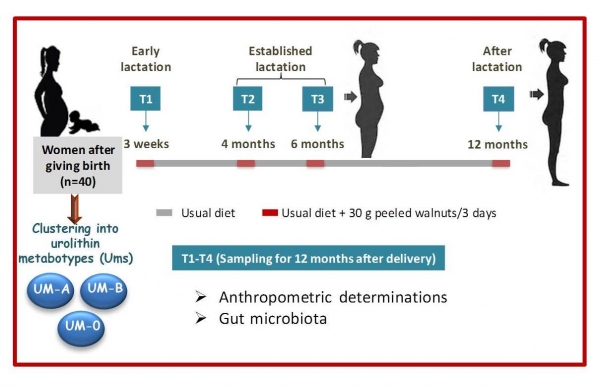Gut microbiota composition greatly varies among individuals. Some bacterial groups can metabolize dietary polyphenols, such as the ellagitannins occurring in walnuts, pomegranate, strawberries, etc., which are metabolized to the final molecules so-called urolithins (Uros). These metabolites exert in vivo anti-inflammatory, cardioprotective, and neuroprotective activity.
The population can be stratified, according to the final Uros produced, into different metabolic phenotypes (metabotypes), i.e., urolithin metabotypes (UMs): metabotype A (UM-A) that only produces Uro-A, metabotype B (UM-B) that yields Uro-B, IsoUro-A, and Uro-A, and metabotype 0 (UM-0), which does not produce Uros. During pregnancy, the gut microbiota is profoundly altered, resulting in a transitory dysbiosis status (microbial imbalance), which can persist several months after delivery. Pregnancy can be a significant contributor to obesity among women through the retention of weight gained during gestation, as well as to the development of cardiovascular diseases. And it is also known that not all women respond in the same way in the recovery of their silhouette (BMI, weight, waist, and hip circumference). This work evaluated the possible contribution of UMs in the restoration of both anthropometric values and gut microbiome ecology postpartum. Urine and feces samples from 40 healthy women were analyzed at 3 weeks, 4, 6, and 12 months after delivery. The percentage of mothers who lost weight (≥ 2 kg) was higher in the UM-A group (75%) versus UM-B (54%). Moreover, the gut microbiota of UM-A mothers changed over time, suggesting that a restoration of the gut microbiota is happening, unlike gut microbiota of UM-B mothers, which barely changed over 1 year. Besides, some UM-B microbial groups were inversely associated with a reduction of BMI, waist, and waist-to-hip ratio, while the discriminating bacteria genus for UM-A, Gordonibacter, correlated to the decrease of the women’s waist. Therefore, this study concludes that UM-B is associated with a more robust and less modulating microbial and anthropometric profiles versus UM-A, in which these profiles were normalized through the 1-year follow-up postpartum. Consequently, these results suggest that the determination of UMs in pregnant and lactating women could be a useful tool to estimate their predisposition to the recovery of the gut microbiota and anthropometric values after delivery.
For more information:
https://www.mdpi.com/2072-6643/11/9/2079

